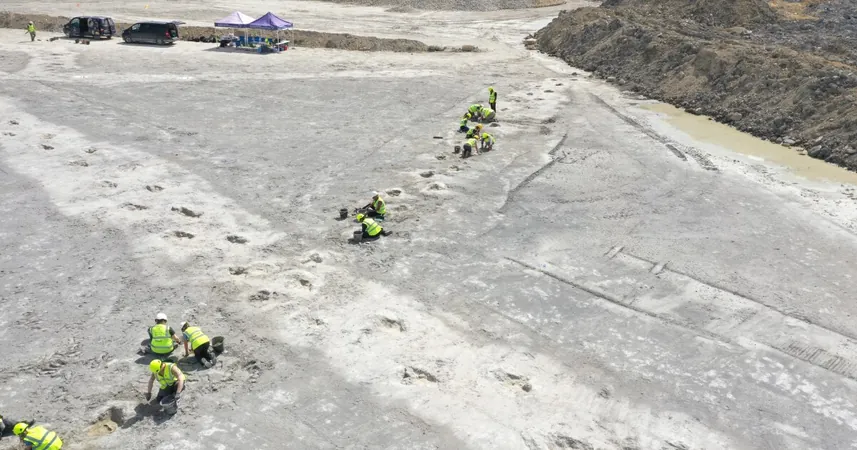
Incredible Discovery: Jurassic Dinosaur Footprints Unearthed on a 'Dinosaur Highway' in Southern England!
2025-01-04
Author: Arjun
In an astonishing turn of events that began last June, a worker at Dewars Farm Quarry in Oxfordshire, southeast England, stumbled upon what would soon be revealed as one of the most significant paleontological discoveries in recent years. As he dug into the clay, he felt "unusual bumps" beneath his tools, leading a team of over 100 dedicated researchers from the Universities of Birmingham and Oxford to investigate further.
The findings from this site have turned out to be nothing short of spectacular, with paleontologists confirming that these bumps were, in fact, ancient dinosaur tracks dating back approximately 166 million years to the Middle Jurassic period. Researchers meticulously mapped out five distinct trails consisting of around 200 footprints, offering unprecedented insights into the behavior, size, and speed of these prehistoric giants.
Among the fascinating highlights is the revelation that the dinosaurs likely walked at a leisurely pace rather than sprinting. Kirsty Edgar, a micropalaeontology professor involved in the excavation, explained that, "All of the dinosaurs, based on our estimates of speed, were probably walking rather than running." This insight paints a vivid picture of these ancient creatures traversing their environment, which researchers suggest resembled the modern-day Florida Keys, likely characterized by lagoon-like settings.
The team uncovered multiple trackways, with the longest stretching nearly 500 feet. Strikingly, four of these paths belong to gigantic herbivorous sauropods, specifically the enormous 60-foot-long Cetiosaurus, while a fifth trail was made by the predatory Megalosaurus, a fearsome dinosaur measuring about 30 feet long. This particular carnivore is well-known for its large, three-toed claws and holds the distinction of being the first dinosaur ever scientifically named, a title it earned back in 1824 thanks to Oxford geologist William Buckland. Buckland's groundbreaking discovery marked the beginning of more than two centuries of dinosaur research and fascination.
Intriguingly, some tracks from the Megalosaurus and the sauropods appeared to overlap, provoking questions regarding the interaction between these two species in their shared ecosystem. Emma Nicholls, a vertebrate palaeontologist at the Oxford Museum of Natural History, noted, "Scientists have known about and been studying Megalosaurus for longer than any other dinosaur on Earth, and yet these recent discoveries prove there is still new evidence of these animals out there, waiting to be found." This statement emphasizes the endless potential for new discoveries lurking beneath our feet.
Measurements of the Megalosaurus tracks, each around 25 inches in length, suggest that this formidable predator had a stride of approximately 8.8 feet, leading scientists to estimate its walking speed at about 3 miles per hour—remarkably similar to the average pace of an adult human. Beliefs have grown that the much larger sauropods, too, traversed their environment in a similar manner.
The discovery of dinosaur tracks in this area is not a recent phenomenon; it dates back to 1997 when quarry workers initially found over 40 sets of dinosaur footprints, with some trackways reaching lengths of up to nearly 600 feet. In recognition of its importance, the British government designated the Oxfordshire site as one of the world's most crucial dinosaur track locations, offering essential clues about the species that once roamed the U.K. during the Middle Jurassic Period.
In this latest excavation endeavor, researchers have taken over 20,000 images of the unearthed footprints, ensuring that these valuable records of prehistoric life are preserved for future study and fascination. This groundbreaking discovery not only enhances our understanding of ancient life on Earth but also stirs excitement about what further secrets the past may still hold beneath our very feet!
 Brasil (PT)
Brasil (PT)
 Canada (EN)
Canada (EN)
 Chile (ES)
Chile (ES)
 Česko (CS)
Česko (CS)
 대한민국 (KO)
대한민국 (KO)
 España (ES)
España (ES)
 France (FR)
France (FR)
 Hong Kong (EN)
Hong Kong (EN)
 Italia (IT)
Italia (IT)
 日本 (JA)
日本 (JA)
 Magyarország (HU)
Magyarország (HU)
 Norge (NO)
Norge (NO)
 Polska (PL)
Polska (PL)
 Schweiz (DE)
Schweiz (DE)
 Singapore (EN)
Singapore (EN)
 Sverige (SV)
Sverige (SV)
 Suomi (FI)
Suomi (FI)
 Türkiye (TR)
Türkiye (TR)
 الإمارات العربية المتحدة (AR)
الإمارات العربية المتحدة (AR)